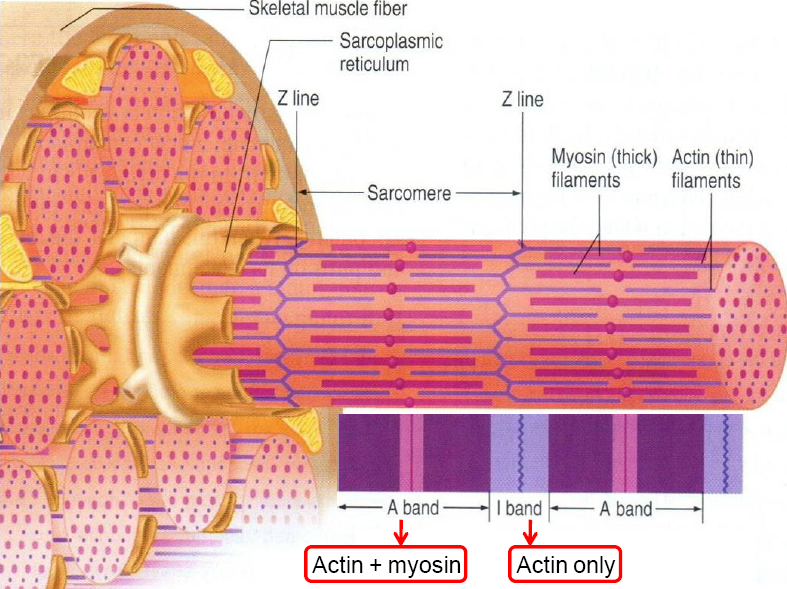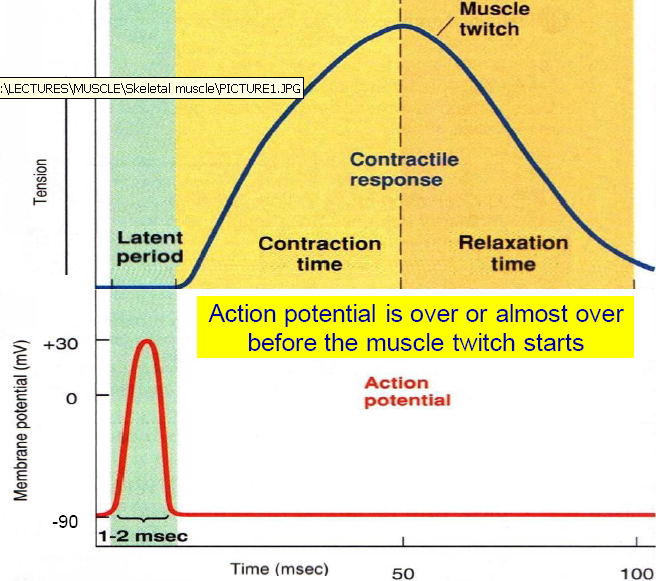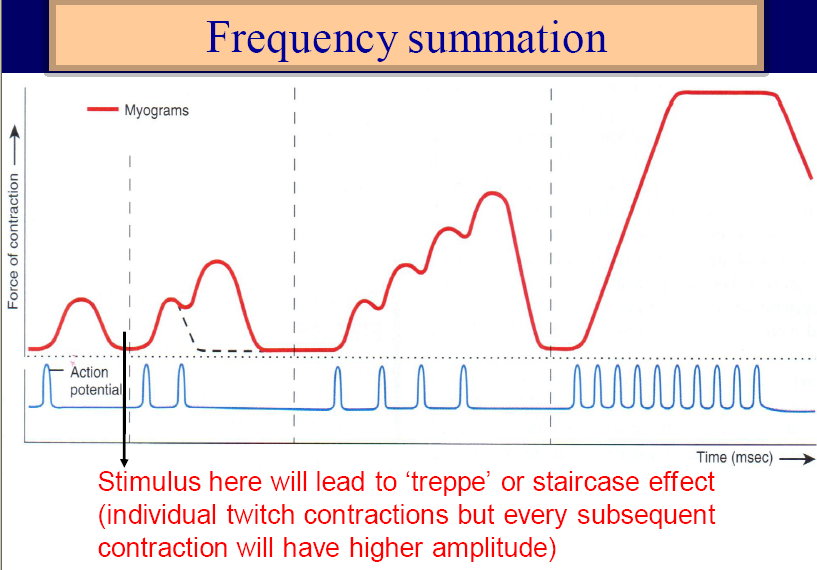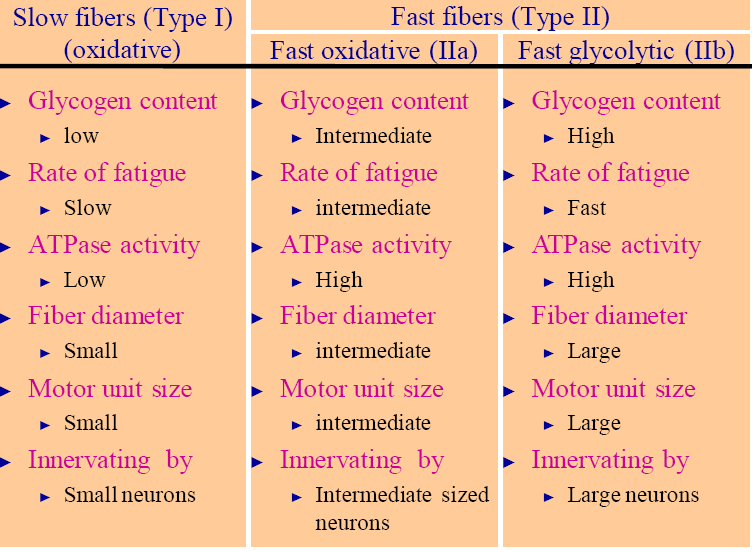A muscle is an excitable tissue having ability to contract. There are three types of muscles:
1) Skeletal muscle
2) Smooth muscle
3) Cardiac muscle
Skeletal Muscle
►Striated appearance
►Under voluntary control
►Innervated by somatic motor nerve
►About 40 % of body weight
A muscle fiber or simply a muscle cell consists of:
►Sarcolemma
►‘T’ tubules
►Sarcoplasm
►Sarcoplasmic reticulum
►Mitochondria
►Myofibrils
►Myofilaments
Actin
►Thin filaments -double the number, half the diameter
Myosin
►Thick filaments -half the number, double the diameter
Special arrangement of actin and myosin filaments give striated appearance to skeletal muscle.
‘I’ bands (less dense)
►Contain actin only with ‘Z’ line in center
‘A’ bands (more dense)
►Contain both actin and myosin
‘H’ zone
►Central zone occupied by myosin only
‘M’ line
►unites myosin filaments with each other
►Binds with titin protein and anchors myosin
Actin filament:
Composed of three proteins
►Actin
Contain active sites
►Tropomyosin
Covers active sites
►Troponin (I, C, T)
Binds tropomyosin to actin
Myosin filament
Composed of myosin molecules
►Two heavy and four light chains
►Tails of molecules form body of filament
►Heads form cross bridges
Sarcomere
►Structural and functional unit of muscle fiber
►Lies between 2 successive ‘Z’ lines
Sarcomere -resting length = 2.2 μm
►Maximum overlap of myosin heads with actin
►Length of myosin filament = 1.6 μm
►Length of actin filament = 1μm
Skeletal muscle contraction
Sliding filament mechanism walk along theory)
►Process by which sarcomere shortens and contraction takes place
►Pulling inwards of actin filaments
►Myosin heads bind with active site of actin
►Power stroke occurs and actin filaments slide inwards over myosin filaments
General mechanism
►Generation of action potential in muscle fiber
►Spread of action potential along sarcolemma and deep in the cell through ‘T’ tubules
►Release of Ca++ions from sarcoplasmic reticulum
►Uncovering of active sites of actin
►Binding of myosin heads to actin
►Contraction by sliding filament mechanism
Molecular mechanism
►Actin & myosin love story
►Role of tropomyosin as villain
►Role of Ca++in the love story
►Energization of myosin head by cleaving ATP
►ADP and Pi remain attached
►Release of Ca++from sarcoplasmic cistern
►Binding of Ca++with Troponin C
►Uncovering of active sites of actin
►Binding of myosin heads with actin
►Power stroke
►Bending of cross bridge and inward movement of actin
►Detachment of ADP from myosin heads
►Binding of new ATP with myosin head
►Detachment of myosin heads from actin
►Myosin head energized by cleaving ATP into ADP and Pi & ready for new cycle
Relaxation
►When cytosolic Ca++decreases
►Pumping of Ca++back into sarcoplasmic reticulum
►Role of Ca++pump located at sarcoplasmic reticular membrane
►Energy consuming process -requires ATP
►Release of Ca++from troponin C
►Blocking of active sites of actin
During contraction
►One end of muscle remain fixed, other end shortens
►Centre of sarcomere slides towards fixed end
Utilization of ATP
►Energization of myosin head
►Detachment of myosin heads from actin
►Removal of Ca++from cytosol
Sources of energy for muscle contraction
►Continuous supply of ATP is essential
►Creatine phosphate
►Oxidative phosphorylatoin
►glycolysis
Rigor mortis
►Contracture of muscles after death
►Cause
►Non availability of ATP
►Cytosolic Ca++rises (failure of Ca++pump)
►Myosin heads can not detach from actin
►Subsides after several hours/days
►Due to destruction of contractile proteins
Excitation contraction coupling
►Series of events by which muscle excitation leads to its contraction
►Propagation of action potential from sarcolemma into ‘T’ tubules
►Activation of dihydropyridine (DHP) receptors
►Opening of ryanodine channel and Ca++influx
►Binding of Ca++with troponin C
►Uncovering of active sites of actin
►Binding of myosin heads with actin
►Contraction by sliding filament mechanism
Release of Ca++from sarcoplasmic cistern couples excitation with contraction
Length tension relationship
Tension generated during contraction depends upon initial sarcomere length
Resting length
►Sarcomere length 2 to 2.2 μm
Maximum myosin & actin overlap is possible
►Maximum tension is produced
Sarcomere length > or < than resting length
Actin & myosin overlap not optimal
►Less tension produced
Tension generated during contraction
►Depends upon number of myosin heads bound to actin
►If actin slides inwards
►Sarcomere (or the whole muscle) shortens
►If actin can not slide
►Sarcomere (or the whole muscle) length remains the same
Tension
►Force exerted by a contracting muscle on an object
Load
►Force exerted by the object on muscle
Tension & load are opposing forces
Whether muscle fiber will shorten during contraction or remain the same depends upon relative magnitudes of tension and load
Isometric contraction
►Tension during contraction increases but length of muscle remains the same
►Load > tension
►Trying to lift heavy loads (but not actually lifting up)
Isotonic contraction
►Tension during contraction remains the same but muscle length changes
1) Concentric isotonic contraction
►Load < tension
►Muscle shortens during contraction
►Lifting a weight up running, walking etc
2) Eccentric isotonic contraction
►Load > tension
►Already contracted muscle lengthens
►Lowering a weight to ground
Simple muscle twitch
►Mechanical response of a single muscle fiber to a single action potential
►Latent period (10 ms)
►Contraction period (40 ms)
►Relaxation period (50 ms)
►Total duration -100 ms (varies)
►Doesn’t have refractory period
Motor unit
►A motor neuron and all the muscle fibers it innervates constitutes a motor unit
►Motor unit recruitment
►Activation of more & more motor units
►Initially smaller than larger units (size principle)
►Asynchronous recruitment
►Alternating motor unit activity
►Delays fatigue
►Provides smooth contraction even at low frequency
Summation
►Adding together of individual twitch contractions to increase the intensity of overall muscle contraction
1) Multiple fiber summation
2) Frequency summation
Multiple fiber summation
►More the fibers (motor units) taking part in contraction more will be the force of contraction
►For weak contraction, smaller and fewer motor units are stimulated
►For stronger contractions more & more motor units are stimulated (recruitment)
Frequency summation, tetanus or tetanization
►Sustained contraction due to repeated stimuli of high frequency
►Incomplete tetanization
►Complete tetanization
Incomplete tetanization
►Muscle fiber is stimulated at such a frequency that every next stimulus falls during previous relaxation period
►Subsequent contraction is superimposed on the previous relaxation
►Force of subsequent contractions rises due to beneficial effect of Ca++
►Muscle fiber partially relaxes between stimuli
Complete tetanization
►Muscle fiber is stimulated at such a frequency that every next stimulus falls during previous contraction period
►Subsequent contractions merge with the previous ones
►Smooth contraction of greater force is achieved
►No relaxation phase
►Leads to fatigue
Muscle fatigue
►Decrease in muscular activity due to repeated stimuli
Causes
a.In muscle
►Lack of nutrients and glycogen
►Lack of oxygen
►Accumulation of lactic acid
►Conduction failure along ‘T’ tubules -blockage of Ca++release for sarcoplasmic cistern
b. In Neuromuscular junction
►Depletion of Acetyl choline
3. In CNS
►CNS cannot send excitatory signals to the contracting muscles
►Generally psychological
►Fatigue reverses by taking rest
Muscle fiber types
►On the basis of contraction velocity
1) Slow
2) Fast
►On the basis of formation of ATP
1) Oxidative
2) Glycolysis
Three types
►Slow oxidative fibers
►Low myosin ATPase activity
►High oxidative capacity
►Fast oxidative fibers
►High myosin ATPase activity
►High oxidative capacity
►Intermediate glycolytic capacity
►Fast glycolytic fibers
►High myosin ATPase activity
►High glycolytic capacity
Muscle tone
►Tautness in muscle when at rest
►Due to continuous firing of some motor neurons
►Contraction of some motor units
►Alternating pattern of motor units contraction
Remodeling of muscle
►Muscle remodels to match its function
Hypertrophy
►Increase in total mass of muscle
►Occurs in strength exercise (anaerobic exercise) -weight lifting
►Increase in fiber size
►Increase number of actin and myosin
►Change in metabolic machinery
Atrophy
►Decrease in total mass of muscle
►Denervation atrophy
►Abolishment of trophic signals
►Disuse atrophy
►When muscle is not used for long time
Clinical physiology
►Hypocalcemic tetany
►↓ ECF Ca++→ ↑ Na+permeability
►Spontaneous contractions
►Muscle cramps
►Involuntary tetanic contractions due to abnormally high rates of action potentials
►due to over-exercise
►Dehydration
►Electrolyte imbalance
 howMed Know Yourself
howMed Know Yourself






